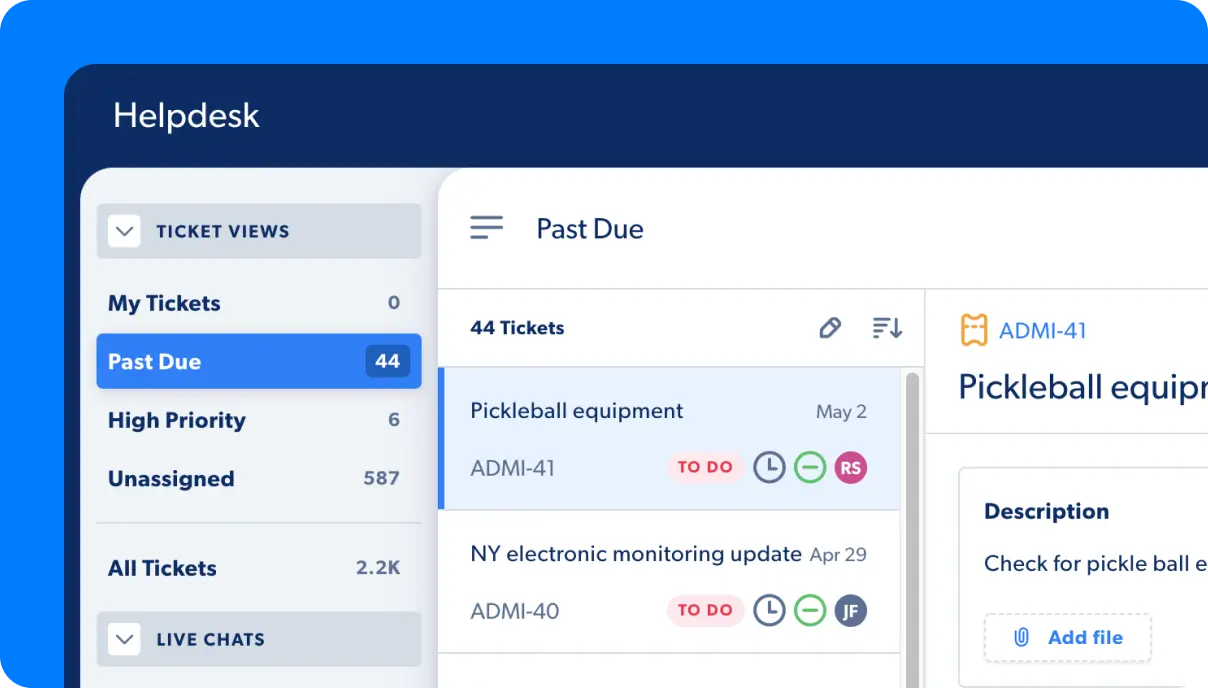Among popular support team buzzwords such as automation, live chat, knowledge base, and ticket management, is helpdesk. For most professionals, the term conjures up images of headset-wearing support agents fielding inbound questions about password resets, account details, other common FAQs.
With that said, let’s pause to make an important distinction. Though it can assist with most of the tasks normally handled by desk agents, the term “helpdesk” in this blog refers to a category of AI-powered software tools.
That’s right, helpdesk solutions have been infused with AI, and they’re more powerful than ever. In fact, the biggest beneficiaries of AI and machine learning (ML) tech in the workplace are digital helpdesk solutions.
Who should use helpdesk solutions?
Support expectations are skyrocketing for both consumers and employees. In fact, 88% of customer support leaders say customer expectations are higher than ever before.
And that’s far from the only reason service desk tools are gaining popularity. Fast turnaround time for internal support requests goes a long way towards a great employee experience. As the spotlight on a healthy corporate culture intensifies, helpdesk solutions will play a crucial role.

Helpdesk solutions benefit internal teams and external customers. From answering common FAQs to automating workflows, a helpdesk solution can help in many ways.
You may be thinking, “That’s great, but how do I determine whether or not my org needs a helpdesk?” As the title of this blog suggests, we’re discussing that below! So without further adieu, check out some common support team symptoms that only a helpdesk solution can cure:
1. Backlogged or delayed help tickets.
As businesses expand, the number of inbound requests for data and knowledge grows. Without assistance from helpdesk software, support teams can only do so much. Bound by the ability to type answers and respond to phone calls, service tickets begin to stack up.
If you’ve noticed that a first response to service tickets takes more than 12 hours (a commonly-accepted average), it’s time to consider a helpdesk solution. While waiting a day or two for help might not sound like a big deal, in theory, the irritation of information bottlenecks can reduce customer satisfaction and employee retention rates over time.
The desk difference:
Plugged into your knowledge base, a digital helpdesk empowers teammates and customers to answer their own questions via an AI-powered chatbot. Through a chat window embedded on your site and favorite communication tools, a helpdesk solution returns instant answers.
With a chatbot providing 24/7/365 support, ticket resolution times plummet, and both internal and external users can go back to the activities that matter most.
For your support team, this means:
- Decreased number of tickets being created in the first place.
- Increased positive internal and external interactions.

2. Answering the same questions over and over.
By necessity, your support staff is made up of subject matter experts (SMEs). Trained by years of troubleshooting and cross-department collaboration, they’ve become well-versed in nearly every facet of your business.
So, why should they burn hours of their day responding to common FAQs? If you find your teammates are regularly spending their precious time answering simple FAQs, we’d recommend taking a closer look at a helpdesk solution.
The desk difference:
Not only can an AI-powered helpdesk lead users to the information they need via guided conversation technology, machine learning (ML) also enables the chatbot to automatically detect and update your knowledge base when new FAQs pop-up.
In some instances, simply offloading FAQs to a helpdesk tool creates 25% more productive time in your support employees’ workday. And if a question can’t be answered via stored knowledge or AI technology, the question will be rerouted to a dedicated human live chat agent to help.
Once the internal agent shares the requested info, it is automatically added to your knowledge base for future inquiries.
For your support team, this means:
- FAQs are automatically answered through a user’s preferred communication channel.
- ML technology automates knowledge base maintenance with new or modified FAQ responses.

3. Managing multiple sources of information.
Ah, the dreaded information silo. If you’re unfamiliar, we’ll shed some light on this productivity parasite. The typical modern enterprise utilizes hundreds of custom applications to function, each one of them packed with crucial data and knowledge. Additionally, these orgs will use countless docs and spreadsheets for further information management.
And each app or file has the potential to become an information silo—constraining the information within the native search tool. If this sounds familiar for your support staff, a helpdesk solution could be in order.
The desk difference:
Modern helpdesk solutions offer application integration and document mining as standard features. This marriage of an AI-enabled chatbot and organizational knowledge creates the lowest barrier to information that’s ever existed.
Through the chat window we alluded to earlier, customers and employees can deploy your chatbot into the apps and docs to find whatever information they might require. In seconds, Capacity can navigate CRM, e-commerce, or project management software (among MANY others), and return helpful replies to inbound inquiries.
For your support team, this means:
- Instant access to knowledge across hundreds of apps, docs, and spreadsheets.
- Reduced workload thanks to a drastically increased ability for users to self-serve.
Artificial intelligence, real benefits.
If any of these signs hit home for you, you’re not alone. Around the world, companies are figuring out how to adapt to increasing customer and employee experience standards. For many, an AI-powered helpdesk solution is the tip of the support automation spear, deflecting FAQs and minimizing wait times.











































